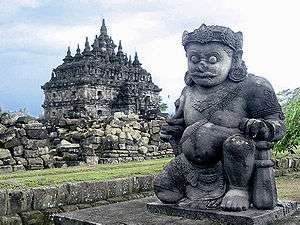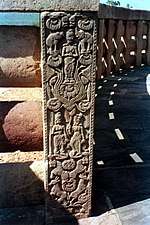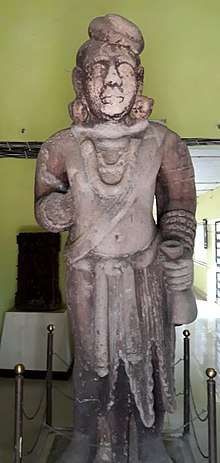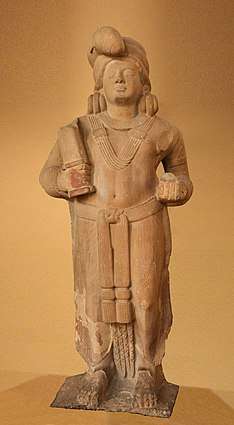Yaksha
The yakshas (यक्ष Sanskrit: yakṣa; Pali: yakkha) are a broad class of nature-spirits, usually benevolent, but sometimes mischievous or capricious, connected with water, fertility, trees, the forest, treasure and wilderness.[4][5] They appear in Hindu, Jain and Buddhist texts, as well as ancient and medieval era temples of South Asia and Southeast Asia as guardian deities.[5][6] The feminine form of the word is yakṣī[7] or yakshini (यक्षिणी Sanskrit: yakṣiṇī; Pali: yakkhinī).[8]
Art of Mathura, Mathura Museum

In Hindu, Jain, and Buddhist texts, the yakṣa has a dual personality. On the one hand, a yakṣa may be an inoffensive nature-fairy, associated with woods and mountains; but there is also a darker version of the yakṣa, which is a kind of ghost (bhuta) that haunts the wilderness and waylays and devours travellers, similar to the rakṣasas.
Early Yakshas
Several monumental yakshas are known from the time the Mauryan Empire period. They are variously dated from around the 3rd century BCE to the 1st century BCE. These statues are monumental (usually around 2 metres tall), and often bear inscriptions related to their identification as yakshas. They are considered as the first known monumental stone sculptures in India. Two of these monumental yakshas are known from Patna, one from Vidisha and one from Parkham, as well as one female Yakshi from Besnagar. The yakṣas may have originally been the tutelary gods of forests and villages, and were later viewed as the steward deities of the earth and the wealth buried beneath.
In early Indian art, male yakṣas are portrayed either as fearsome warriors or as portly, stout and dwarf-like. Female yakṣas, known as yakṣiṇīs, are portrayed as beautiful young women with happy round faces and full breasts and hips.
Kubera
.jpg)
In Hindu, Buddhist and Jain mythology, Kubera (Sanskrit; Pali: कुबेर; also Kuvera; Tamil: குபேரன்), the god of wealth and prosperity is considered the king of the semi-divine yakshas. He is regarded as the regent of the North (Dikpāla), and a protector of the world (Lokapāla).
His many epithets extol him as the overlord of numerous semi-divine species and the owner of the treasures of the world. Kubera is often depicted with a plump body, adorned with jewels, carrying a money-pot and a club. His plump body denotes his identification as a yaksha. His vahana (vehicle) is the viverrine (mongoose). He is often seen with Lakshmi, the Hindu goddess of wealth, fortune and prosperity.
In Buddhism, he is equated with Vaiśravaṇa.
Yakshas in Buddhism

In Buddhist literature, the yakṣa are the attendants of Vaiśravaṇa, the guardian of the northern quarter, a beneficent god who protects the righteous. The term also refers to the Twelve Heavenly Generals who guard Bhaiṣajyaguru, the Medicine Buddha.
The Mahāmāyūrīvidyārājñī Sūtra, a text that dates back to fourth century or earlier (translated from the Sanskrit by Kumarajiva), gives a large list of yakshas that reside in the classical cities of ancient India[9] who are invoked to seek the protection of the BuddhaDharma:
"The deity Krakucchanda resides in Pataliputra.
Aparajita resides in Sthuno.
The great yaksha Bhadra resides in Saila.
The great deity Manava resides in Uttara.
The great sage Vajrapani though lives in Rajagrha
Often dwells in Mount Grdhrakuta.
The deity Garuda resides in the Vipula mountain.
Citragupta resides in Citemukha.
The yaksha Vakula resides in Rajagrha.
...
The yaksha king Mahagiri resides in Girinagara.
The yaksha Vasava resides in Vaidisa.
The yaksha Karttikeya resides in Rohitaka.
This yaksha Kumara is renowned in the great city.
...
Vaisravana who resides in the city Alakavati,
Located along the jewelled stairway of the Buddha’s descent,
Is surrounded by billions of gods and goddesses.
Such yakshas command huge and powerful contingents of troops
To subjugate adversaries and enemies,
Conquering all.
They are famous throughout all directions.
Imbued with great dignity and virtue,
They come to aid
In the battles between the heavens and asuras.
These deities of virtues and great yaksha generals are located everywhere in Jambudvipa. They uphold and protect the Buddhadharma, generating compassion."
[10]
Yakshas in Jainism
Jains mainly maintain cult images of Arihants and Tirthankaras, who have conquered the inner passions and attained moksha. Yakshas and yakshinis are found in pair around the cult images of Jinas, serving as guardian deities. The yaksha is generally on the right-hand side of the Jina image while the yakshini is on the left-hand side. They are regarded mainly as devotees of the Jina, and have supernatural powers. They are also wandering through the cycles of births and deaths just like the worldly souls, but have supernatural powers.[11]
The Harivamsapurana (783 CE) refers to them as Shasandevatas. Initially among the yakshas, Manibhadra and Purnabadra yakshas and Bahuputrika yakshini were popular. The yaksha Manibhadra is worshipped by the Jains affiliated with the Tapa Gachchha. During tenth and thirteenth centuries yaksha Saarvanubhuti, or Sarvahna and yakshinis Chakreshvari, Ambika, Padmavati, and Jwalamalini became so popular that independent temples devoted to them were erected.
The yakshas and yakshinis are common among traditional Murtipujak Shvetambara and Bispanthi Digambar Jains. The Digambara Terapanth movement opposes their worship.[12][13] Among the Murtipujak Shvetambaras, the Tristutik Gaccha sect (both historical founded by Silagana and Devabhadra, and the modern sect organised by Rajendrasuri) object to the worship of shruta-devatas.[14]
Shasan devatas in Jainism
In Jainism, there are twenty-four yakshas and twenty-four yakshis that serve as shasan-devatas for the twenty-four tirthankaras:.[15] These yakshas are as follows:
- Gomukha
- Mahayaksha
- Trimukha
- Yaksheshvara or Yakshanayaka
- Tumbaru
- Kusuma
- Varanandi or Matanga
- Vijaya or Shyama
- Ajita
- Brahma or Brahmeshvara
- Ishvara or Yakset
- Kumara
- Dandapani
- Patala
- Kinnara
- Kimpurusha or Garuda
- Gandharva
- Kendra or Yakshendra
- Kubera
- Varuna
- Bhrikuti
- Gomedha or Sarvahna
- Dharanendra or Parshvayaksha
- Matanga
Yakshas in poems
In Kālidāsa's poem Meghadūta, for instance, the yakṣa narrator is a romantic figure, pining with love for his missing beloved. By contrast, in the didactic Hindu dialogue of the Yakṣapraśnāḥ "Questions of the Yakṣa", it is a tutelary spirit of a lake that challenges Yudhiṣṭhira.
In Mahavamsa poem of Sri Lanka, a local population is given the term Yakkhas. Prince Vijaya encountered the royalty of the yakkhas' queen, Kuveni, in her capital of Lanka pura, and conquered them. The Yakkhas served as loyal subjects with the House of Vijaya and the yakkha chieftain sat on equal height to the Sri Lankan leaders on festival days.
Yakshas in Thailand
Yakshas (Thai: ยักษ์, RTGS: Yak) are an important element in Thai temple art and architecture.[16] They are common as guardians of the gates in Buddhist temples throughout the country since at least the 14th century. Ceramic sculptures of guardian yakshas were produced in Thailand, during the Sukhothai and Ayutthaya periods, between the 14th and 16th centuries, at several kiln complexes in northern Thailand.[17] They are mostly depicted with a characteristic face, having big round bulging eyes and protruding fangs, as well as a green complexion. Yakshas and their female counterparts are common in the Buddhist literature of Thailand, such as in The Twelve Sisters and Phra Aphai Mani. As ogres, giants, and ogresses, yakshas are present as well in Thai folklore.
"ย ยักษ์", (yo yak) is also used as an illustration in order to name the letter ย, the 34th consonant of the Thai alphabet, according to the traditional letter symbols Thai children use to memorise the alphabet.[18]
In popular culture
- Anime and manga series Inuyasha follows the story of a protagonist of the same name, which literally translates to "Dog Yaksha."
- Anime and manga series One Piece features a character named Donquixote Doflamingo, whose epithet is "Heavenly Yaksha."
- Anime and manga series Gin Tama follows protagonist Sakata Gintoki, once referred to as Shiroyasha (White Yaksha).
- Yasha is the name of the main antagonist in the first Yu Yu Hakusho film.
- Yaksha is one of the 5 characters in the remastered video game The Ninja Warriors Once Again.
- Fist of the North Star features a character named Black Yaksha near the end of the series.
Gallery
 Yaksha couple standing on lotus leaves, the male (sic) holding a lotus bud and posed in shalabhanjika
Yaksha couple standing on lotus leaves, the male (sic) holding a lotus bud and posed in shalabhanjika- Dvarapala Yaksha made of basalt. Statue found in Buddhist cave (Pitalkhora) and dates to 2nd century CE. On display in the Prince of Wales Museum.
_Brahma_image_in_the_mantapa_in_the_Jain_temple_at_Lakkundi.jpg) Chaturmukha, a four-faced Brahma image at Lakkundi Jain Temple, 11th century CE
Chaturmukha, a four-faced Brahma image at Lakkundi Jain Temple, 11th century CE- Mudgarpani Yaksha, 2nd century BCE, Bharnakalan, Mathura Museum.
 Vidisha Yaksha, 2nd century BCE, Vidisha Museum.
Vidisha Yaksha, 2nd century BCE, Vidisha Museum.- Gomedh and Ambika at Maharaja Chhatrasal Museum, 11th century
See also
Notes
- Dated 100 BCE. Quintanilla, Sonya Rhie (2007). History of Early Stone Sculpture at Mathura: Ca. 150 BCE – 100 CE. BRILL. p. 368, fig. 88. ISBN 9789004155374.
- Quintanilla, Sonya Rhie (2007). History of Early Stone Sculpture at Mathura: Ca. 150 BCE – 100 CE. BRILL. p. 365, fig. 85. ISBN 9789004155374.
- Dalal, Roshen (2010). The Religions of India: A Concise Guide to Nine Major Faiths. Penguin Books India. p. 398. ISBN 978-0-14-341517-6.
- Singh (2008). A History of Ancient and Early Medieval India. New Delhi: Pearson Education. p. 430. ISBN 978-81-317-1120-0.
- "yaksha". Encyclopædia Britannica. Retrieved 15 July 2007.
- Richard John Richards (1995). South-east Asian Ceramics: Thai, Vietnamese, and Khmer: From the Collection of the Art Gallery of South Australia. Oxford University Press. pp. 27, 67. ISBN 978-967-65-3075-2.
- For यक्षी as the feminine of यक्षः see V. S. Apte, The Practical Sanskrit-English Dictionary, p. 776.
- For yakṣiṇī (यक्षिणी) as a regular Sanskrit term for a female yakṣa, and yakṣaṇī as a Buddhist variant, see Franklin Edgerton, Buddhist Hybrid Sanskrit Grammar and Dictionary, Vol. 2, Motilal Banarsidass, first Ed., 1953, p. 442.
- [V. S. Agravala, " Geographical Contents of Mahamayuri JUPHS, Vol. XV, Pt. ii, 1942, p. 28]
- "The Mahamayuri Vidyarajni Sutra 佛母大孔雀明王經". 10 June 2012. Retrieved 31 December 2019.
- Pramodaben Chitrabhanu, Jain symbols, Ceremonies and Practices
- [Studies in Jaina History and Culture: Disputes and Dialogues, edited by Peter Flügel, Routledge, 2006 p. 352]
- "Indian Antiquary". Popular Prakashan. 31 December 1903. Retrieved 31 December 2019 – via Google Books.
- Jain, Shalin (2012). "Divided Identities: The Jain Sects in Medieval India". Proceedings of the Indian History Congress. 73: 450–60. JSTOR 44156237.
- http://www.jaindharmonline.com/tirthan/tirsum.htm
- "Thai temples - page 2/7". www.thaiworldview.com. Retrieved 31 December 2019.
- Samuel P. Harn Museum of Art, Gainesville, Florida
- "Thai Alphabet in Letters". www.thailandbuddy.com. Retrieved 31 December 2019.
References
- Dictionary of Hindu Lore and Legend (ISBN 0-500-51088-1) by Anna Dhallapiccola
- Encyclopædia Britannica: "Yaksha"
External links




